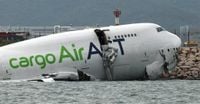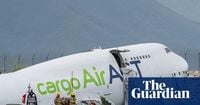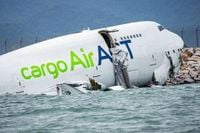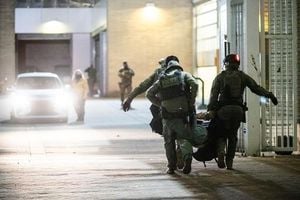In the early hours of October 20, 2025, Hong Kong International Airport—long regarded as one of the world’s safest and busiest aviation hubs—was rocked by one of the deadliest incidents in its 27-year history. At around 3:50 a.m. local time, Emirates flight EK9788, a Boeing 747-400 cargo plane wet-leased from Turkish carrier ACT Airlines, arrived from Dubai and attempted to land on the airport’s north runway. What should have been a routine landing turned disastrous in mere seconds.
According to officials cited by the BBC, the aircraft veered unexpectedly off its designated path, crashed through the perimeter fencing, and struck a security patrol vehicle traveling on a road outside the runway’s fencing. The force of the impact pushed the vehicle into the sea. Tragically, the two airport security staff inside—men aged 30 and 41, with seven and twelve years of experience respectively—were killed. One was confirmed dead at the scene, while the other died later in hospital. Their vehicle was found five meters from the shore, submerged seven meters underwater.
The scene was chaotic but met with a swift response. More than 200 emergency personnel, including fire engines and rescue boats, were dispatched to the crash site, as reported by CNN. Divers managed to locate and retrieve the bodies of the two ground staff after about 40 minutes. The four crew members aboard the plane, who had opened the aircraft’s emergency doors shortly after the crash, were rescued by fire service staff who arrived within two minutes. All four were transported to local hospitals for medical evaluation, but none sustained serious injuries.
Images from the aftermath tell a grim story. The plane had broken in two, with its tail section snapped off and the front section below the cockpit badly damaged. The fuselage was left partially submerged in the shallow waters off the north runway, with large cracks visible along its body. At least one emergency evacuation slide had deployed successfully, a small mercy amid the devastation.
Steven Yiu, Executive Director of Airport Operations at Hong Kong International Airport, addressed the media just hours after the incident. He clarified that the patrol car was "at a safe distance from the runway" and emphasized, “The patrol car definitely did not run out onto the runway; it was the aircraft that overran the runway and struck the patrol car.” The aircraft, according to Yiu, had taxied nearly halfway across the runway before veering off course. Notably, the plane did not send out any distress signals during its approach, nor did it respond to radio calls from the airport—a point echoed by Wesley Yung, technical chief at Hong Kong’s Civil Aviation Department, who told CNN, “We did not receive any request for assistance from the pilots.”
Weather and runway conditions were confirmed to be safe at the time of the incident, with all standard operating protocols in place. Airport officials provided a diagram showing the aircraft’s abrupt left turn halfway down the runway—an inexplicable deviation that remains a key focus of the ongoing investigation. The Hong Kong Air Accident Investigation Authority (AAIA) has launched a comprehensive inquiry, examining factors ranging from pilot actions and aircraft condition to possible mechanical failures and environmental variables. The search for the flight data recorder and cockpit voice recorder, commonly known as the black boxes, is underway, as authorities hope these devices will yield crucial clues.
Emirates, in a statement to the BBC, confirmed that the Boeing 747-481 cargo aircraft was wet-leased from and operated by ACT Airlines, a Turkish carrier. The airline also noted that there was no cargo onboard at the time of the crash and that their crew was safe. ACT Airlines, which provides extra cargo capacity for major airlines, has yet to release further details on the crew’s experience or the aircraft’s maintenance history.
The impact of the crash was immediate and far-reaching. The north runway was closed for the rest of the day, with at least 11 cargo flights scheduled to arrive on October 20 cancelled, according to the Airport Authority’s website. However, with two other runways remaining operational, disruptions to the airport’s more than 1,000 daily flights were minimized. Passenger flights continued largely unaffected, a testament to the airport’s robust contingency planning.
Hong Kong’s transport bureau expressed deep sadness over the loss of the two ground staff, extending condolences to their families and emphasizing the gravity of the incident. The Airport Authority echoed these sentiments, with Steven Yiu stating at a news conference, “Normally the plane is not supposed to turn towards the sea.” He stressed that the airport patrol car was following standard procedures and was not at fault in the sequence of events.
Authorities have not ruled out the possibility of a criminal investigation, though no evidence has yet emerged to suggest foul play. Police officials told the media that all avenues would be explored as part of the probe. Meanwhile, the aviation community is left grappling with the shock of a major accident at a facility celebrated for its safety record.
To put the tragedy in context, fatal aviation accidents are exceedingly rare at Hong Kong International Airport. The last deadly incident occurred in August 1999, when a China Airlines passenger flight crash-landed during a typhoon, resulting in three fatalities. Prior to that, pilots considered the city’s former Kai Tak Airport—located in densely populated Kowloon City—one of the world’s most challenging landing sites. Since the move to Chek Lap Kok in 1998, the new airport has been lauded for its modern design and rigorous safety standards.
Yet, as this week’s accident demonstrates, even the most advanced systems are not immune to tragedy. Investigators now face the daunting task of piecing together the final moments of flight EK9788, hoping to provide answers for the families of the victims and the wider aviation industry. The airport’s north runway will remain closed until the wreckage is removed and authorities complete their initial assessments.
As Hong Kong mourns the loss of two experienced airport workers, the incident serves as a sobering reminder of the risks faced by those who keep the world’s airports running smoothly—even in the pre-dawn hours, when most of the city sleeps.






